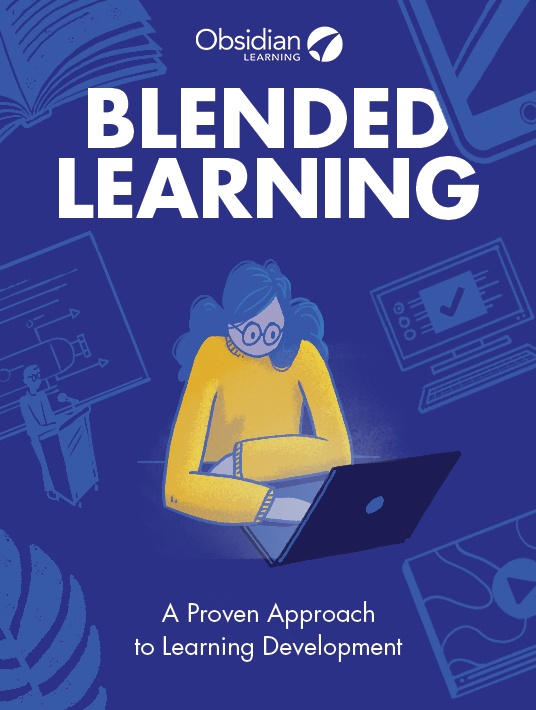Blended Learning Best Practices You Should Apply To Your Organization
Blended learning is one of the most effective approaches for adult learning, as it combines a variety of delivery methods. But as we’ve discussed previously, there are also a variety of blended learning models that can be adapted for use in the corporate learning environment. To help you narrow down your options, in this article, we will address some of the best practices we believe are critical for successful blended learning programs. Many of these best practices are strategies that improve not only program effectiveness, but also your company’s overall ROI.

1. Design From Scratch
As Instructional Designers, we make assumptions about the existing learning outcomes, audience needs, and possibilities. The more thorough the design, the better the outcome.
- Develop and/or vet the learning objectives for the entire program.
- Ensure the design is learner-centric.
- Detail and share the design/syllabus [1] and describe the entire program path, activities, timing, due dates, requirements, etc.
2. Design For The Outcome, Not For Technology
Just because your IT department has released a new mobile learning tool, that doesn’t mean that it absolutely must be incorporated in all courses. Mobile learning, 3D simulations, and VR/AR are all great technologies meant to maximize engagement and help learners acquire knowledge. However, they all have their place in the learning strategy. If the desired outcome of a program is cyber security awareness, for example, developing a full 3D simulation of the office environment with simulated rooms, desks, and computers is probably not necessary. Designing a thoughtful exercise to demonstrate the consequences of various cyber threats would probably be a better fit.
3. Integrate Thoughtfully
We often start a project adapting an existing course. Simply adding online activities to an existing Instructor-Led course is not a sound strategy; this merely increases the learners’ burden without improving efficiency.
- Choose activities and instructional strategies carefully, and be mindful of the workload [2].
- Focus on making the instruction and activities engaging and targeted.
- Less is always more. So, provide resources that can be used during the day-to-day job, without making them part of the instruction.
4. Ground It In Real-Life
Theoretical learning is, of course, necessary, but learners really need to learn how to apply the theory to real-world situations. The application is key.
- Use examples, case studies, exercises, and scenarios to relate the content to the learners’ actual job.
- Consider a "red-thread" exercise that can be built on and accompanies the instruction throughout the program.
5. Space It
We’ve talked before about the forgetting curve [3]. A huge advantage of blended learning is that it can be broken up into pieces. Thoughtfully spreading out the different instructional events and activities will help solidify the content in long-term memory.
6. Make It Memorable
We don’t need all the deliverables to be high-end, but the blended learning program as a whole has to be impactful. Take a look at each piece of the program, and see how you can enhance it by embedding an emotional hook in the activities.
7. Encourage Collaboration
Collaboration can be accomplished through group activities during the Instructor-Led Training portion of the program, but it can also be done through online chats, presentation sharing, and communities of practice. Extending the learner to others, rather than focusing on the individual, creates a much richer experience and moves the focus away from the instructor and toward the learners.
8. Evaluate
Don’t forget to measure the effectiveness of the program. It’s the only way to refine and improve your offerings.
- Establish benchmarks for success and follow up to see if they were met.
- Ask for feedback from the learners and incorporate it into the course – always ensure a continuous improvement loop in your courses.
- Level 1 assessment and evaluations [4] are not sufficient. Push to evaluate at least at Level 3 and perhaps Level 4.
9. Keep An Open Mind
Know that everything changes constantly – science, tools, technologies, people, jobs, requirements, locations, and priorities. Just because a blended learning program was successful last year does not mean it will remain so for the next five years. When updating the content, also review the design, audience needs, and learning objectives. Make sure that the activities are still relevant, that software has not changed, and that the business objectives remain valid.
And rest assured – you are not alone in the world of corporate learning. When in doubt, ask. A rarity among industries, the learning community tends to be collaborative and open to sharing. Learn more about how Obsidian Learning can help you with blended learning or share your questions, thoughts, or suggestions below.
References:
- Best Practices for Use of Blended Learning
- Best Practices for Designing Blended Courses
- Ebbinghaus Forgetting Curve
- Kirkpatrick Model: Four Levels of Learning Evaluation








